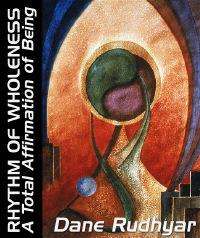 |
| Home | Bio | Art | Music | Literature | Civilization & Culture | Philosophy of Wholeness | Theosophy & Spirituality | Astrology |

RHYTHM OF WHOLENESS A Total Affirmation of Being by Dane Rudhyar, 1983 CONTENTS PROLOGUE PART ONE The Philosophy of Operative Wholeness 1. Prelude to a New Interpretation of Reality 2. The Search for Spiritual Security: The One, the Whole, and Wholeness 3. The Movement of Wholeness Page 1 Page 2 Page 3 Page 4 Page 5 PART TWO The Cycle of Being 4. The Structure of the Cycle of Being 5. The Four Crucial Phases of the Cycle of Being 6. The Inevitability of Success and Failure 7. Spirit and Mind PART THREE The Cycle of Man 8. Constitution of Man - The Physical and Psychic Bodies 9. Constitution of Man - The Spiritual Entity and the Higher Mind 10. The Structure and Transformation of the Total Person 11. The Cyclic Process of Spiritual Embodiment PART FOUR In The Spirit of Wholeness 12. The Principle of Holarchy and the Interplay of Horizontal and Vertical Relationships 13. Transpersonal Activity versus Mediumship 14. Rites of Passage EPILOGUE |

CHAPTER THREE
The Movement of Wholeness - 4 While the philosophy of operative Wholeness is based on the cycle of being (the Movement of Wholeness), it considers the state of objective, measurable, physical existence only one half of the whole cycle of being. It is "one half" in an abstract sense, not in terms of a quantitative, physical measurement of time. However, the other half of the cycle should not be considered nonbeing or non-manifestation. Rather, it is a period during which activity and consciousness are predominantly subjective, just as they are predominantly objective during the half-cycle human beings experience as physical existence. Both periods can be understood if we accept the dualism of objectivity and subjectivity as a permanent feature of the cycle of being. We can logically do so because a dualism is present in the condition of being experienced by all men and women — and in the whole of nature. This dualism manifests most obviously in the two states human beings experience daily, waking consciousness and sleep — and even in the contrast between activity consciously focused on a physical (or intellectual) task and a state of unfocused consciousness (day-dreaming) or passive openness to the flow of change (a state in which the sense of time becomes equally unfocused, which does not mean that time has vanished). Popular Hinduism speaks of the Days and Nights of Brahma, the Creative God; philosophers, of periods or states of manifestation and non-manifestation. In terms of their particular type of consciousness, each refers to what I call the cycle of being in which being oscillates between the two poles represented by the principles of Unity and Multiplicity. Thus the cycle of being inevitably divides itself into two hemicycles, each dominated by one of the two principles. During one hemicycle, the trend toward Multiplicity is dominant and the power or influence of the principle of Unity wanes; this is the hemicycle of multiple beings which in their totality constitute the physical universe perceived by the predominantly objective consciousness of human beings. It can be conveniently symbolized in terms of human experience as the Day period of activity and consciousness. During the other hemicycle, the symbolic Night period, the principle of Unity and the trend toward oneness dominate. The physical world ceases to exist, but "being" always is. It is in a condition of predominant subjectivity which is prefigured in the human condition of sleep or intense meditation. I have called the state of being to which it refers inistence — the polar opposite of existence. Perhaps a more accurate symbolism than Day and Night would relate the interaction of the two principles. Unity and Multiplicity, to the interaction of the Chinese principles Yin and Yang. For Chinese philosophy makes very clear that these two principles operate within the circle of wholeness, Tao, and that they are not only constantly interrelated but interpenetrating. The black form of Yin has a white "center," and the white form of Yang, a black one. Moreover, Yin and Yang, like the principles of Unity and Multiplicity, both operate simultaneously, but in ever-changing ratios of proportional intensity. Indeed, the philosophy of operative Wholeness I present is probably closer to the spirit of Chinese philosophy than to the Hindu, although it includes elements from both approaches. Nevertheless, the more Western symbolism of Day and Night is adequate if we remember that while light and darkness are "eternal" (that is, cyclic) opposites, they coexist. What human beings call death is simply the transition from the Day state to the Night state. It is merely a marker of time which, for a physically embodied human consciousness, indicates a radical change in the experience of the continuum. This change is drastically important, tragic, and frightening to human beings solely because the human consciousness, having built a powerful image of itself as a subject — the utterly precious and worthwhile "I" — fears seeing the realm over which it autocratically ruled disintegrate into seeming nothingness. The fear persists even though what occurs is that each of the constituents of the realm goes its own way; they are scattered but not annihilated. At least some of them will return and reintegrate under the reign of a new, perhaps more worthy "king" of the same dynasty (as we shall see in Chapter II when we study the concept of reincarnation). A human being is a whole, not a "one," and both principles, Unity and Multiplicity, are active in this whole. A human being in his or her wholeness (a person) is both a subject and an object. The statement that a person is both a soul and a body says the same thing within a religious frame of reference. For the religious person, the soul — as a subjective factor in total being and personhood — is the being's most important and valuable component; but (as we shall see) this importance is given because mankind belongs to the last portion of the Day period of the cycle of being, when the power of the principle of Unity is waxing and catching up to the intensity of the principle of Multiplicity, which is in retreat. Thus to increasingly experience and aim at achieving a subjective state of unity is the dharma — the essential function — of mankind on this planet and in our universe (for there may be other, different universes). Religion, inasmuch as it seeks to unify human beings — which, however, it actually does only within the narrow limits of particular cultures, institutions, and dogmas, which exclude all unbelievers — is in tune with the present trend of the continuum of change. So are meditation processes and all aspirations toward an ideal of unity. But if we want to understand why this is so and what occurs if we do not align our wills, minds, and daily behavior with this progressive one-ward trend — and if we allow the still powerful principle of Multiplicity to successfully oppose the natural trend toward Unity during this period of the earth's evolution — we have to develop a focus of mind and intuitive understanding that is more encompassing than that of the religions of particular, exclusivistic cultures. By permission of Leyla Rudhyar Hill Copyright © 1983 by Dane Rudhyar All Rights Reserved.  Web design and all data, text and graphics appearing on this site are protected by US and International Copyright and are not to be reproduced, distributed, circulated, offered for sale, or given away, in any form, by any means, electronic or conventional. See Notices for full copyright statement and conditions of use. Web design copyright © 2000-2004 by Michael R. Meyer. All Rights Reserved. |
 |